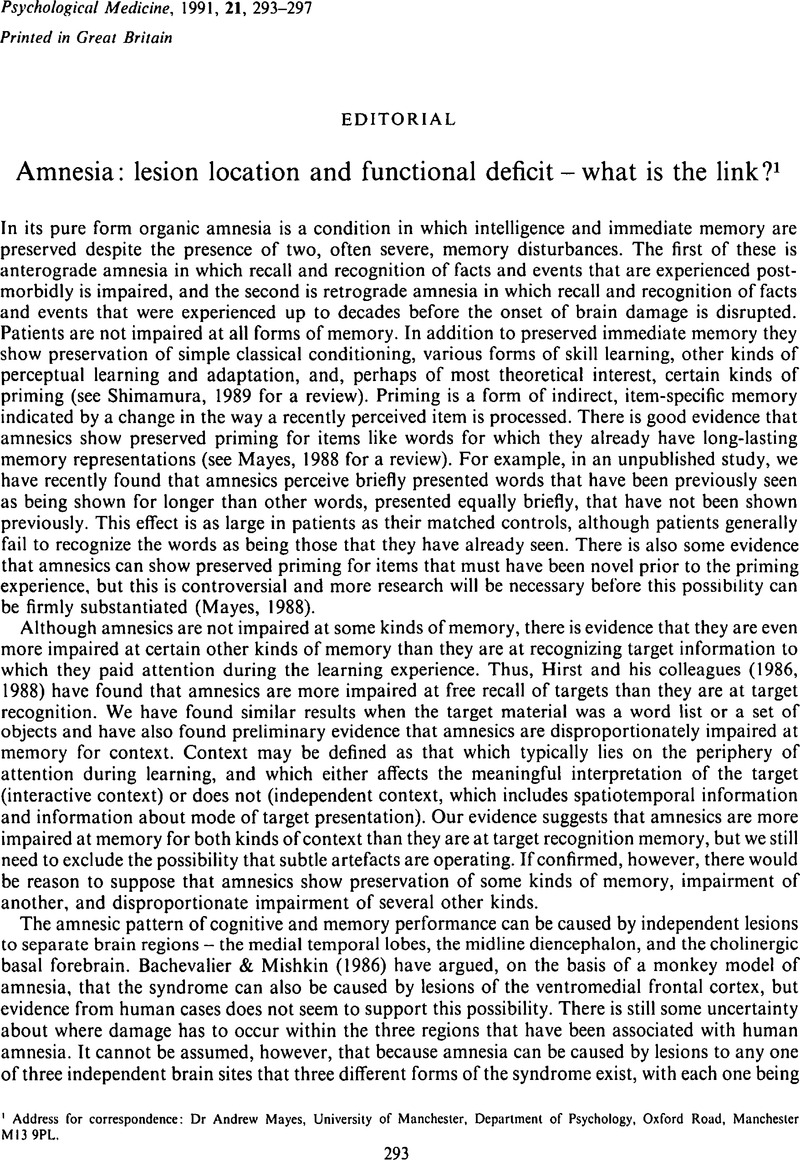No CrossRef data available.
Article contents
Amnesia: lesion location and functional deficit – what is the link?1
Published online by Cambridge University Press: 09 July 2009
Abstract
An abstract is not available for this content so a preview has been provided. As you have access to this content, a full PDF is available via the ‘Save PDF’ action button.

- Type
- Editorial
- Information
- Copyright
- Copyright © Cambridge University Press 1991
References
Aggleton, J. P. & Mishkin, M. (1983 a). Visual recognition impairment following medial thalamic lesions in monkeys. Neuropsychologia 21, 189–197.CrossRefGoogle ScholarPubMed
Aggleton, J. P. & Mishkin, M. (1983 b). Memory impairments following restricted medial thalamic lesions in monkeys. Experimental Brain Research 52, 199–209.CrossRefGoogle ScholarPubMed
Amaral, D. G. (1987). Memory: anatomical organization of candidate brain regions. In Handbook of Physiology: Higher Functions of the Nervous System (ed. Mountcastle, V. B. and Plum, F.), pp. 211–294. American Physiological Society: Bethesda, Maryland.Google Scholar
Bachevalier, J. & Mishkin, M. (1986). Visual recognition impairment follows ventromedial but not dorsolateral prefrontal lesions in monkeys. Behavioural Brain Research 20, 249–261.CrossRefGoogle Scholar
Bachevalier, J., Parkinson, J. K. & Mishkin, M. (1985). Visual recognition in monkeys: effects of separate v. combined transection of fornix and amygdalofugal pathways. Experimental Brain Research 57, 554–561.Google Scholar
Cramon, D. Y. von, Hebel, N. & Schuri, U. (1985). A contribution to the anatomical basis of thalamic amnesia. Brain 108, 993–1008.CrossRefGoogle Scholar
Gentilini, M., De Renzi, E. & Crisi, G. (1987). Bilateral paramedian thalamic infarcts: report of eight cases. Journal of Neurology, Neurosurgery and Psychiatry 50, 900–909.CrossRefGoogle ScholarPubMed
Graf-Radford, N. R., Tranel, D., Van Hoesen, G. W. & Brandt, J. P. (1990). Diencephalic amnesia. Brain 113, 1–25.CrossRefGoogle Scholar
Hirst, W., Johnson, M. K., Kim, J. K., Phelps, E. A., Risse, G. & Volpe, B. T. (1986). Recognition and recall in amnesics. Journal of Experimental Psychology: Learning, Memory and Cognition 12, 445–451.Google ScholarPubMed
Hirst, W., Johnson, M. K., Phelps, E. A. & Volpe, B. T. (1988). More on recall and recognition with amnesics. Journal of Experimental Psychology: Learning, Memory and Cognition 14, 758–762.Google ScholarPubMed
Hunter, R., McLuskie, R., Wyper, D., Patterson, J., Christie, J. E., Brooks, D. N., McCulloch, J., Fink, G. & Goodwin, G. M. (1989). The pattern of function-related regional cerebral blood flow investigated by single photon emission tomography with 99mTc-HMPAO in patients with presenile Alzheimer's disease and Korsakoff's psychosis. Psychological Medicine 19, 847–855.CrossRefGoogle ScholarPubMed
Markowitsch, H. J. & Pritzel, M. (1985). The neuropathology of amnesia. Progress in Neurobiology 25, 189–287.CrossRefGoogle ScholarPubMed
Mayes, A. R. (1988). Human Organic Memory Disorders. Cambridge University Press: Cambridge.CrossRefGoogle Scholar
Mishkin, M. (1982). A memory system in the monkey. Philosophical Transactions of the Royal Society of London B 298, 85–95.Google ScholarPubMed
Phillips, S., Sangalang, V. and Sterns, G. (1987). Basal forebrain infarction: a clinicopathologic correlation. Archives of Neurology 44, 1134–1138.CrossRefGoogle ScholarPubMed
Press, G. A., Amaral, D. G. & Squire, L. R. (1989). Hippocampal abnormalities in amnesic patients revealed by high-resolution magnetic resonance imaging. Nature 341, 54–57.CrossRefGoogle ScholarPubMed
Rolls, E. T. (1989). Parallel distributed processing in the brain: implications of the functional architecture of neuronal networks in the hippocampus. In Parallel Distributed Processing: Implications for Psychology and Neurobiology (ed. Morris, R. G. M.), pp. 286–308. Oxford University Press: Oxford.Google Scholar
Salmon, D. P., Zola-Morgan, S. & Squire, L. R. (1987). Retrograde amnesia following combined hippocampus-amygdala lesions in monkeys. Psychobiology 15, 37–47.CrossRefGoogle Scholar
Shimamura, A. P. (1989). Disorders of memory: the cognitive science perspective. In Handbook of Neuropsychology, Volume 3 (ed. Boiler, F. and Grafman, J.), pp. 35–73. Elsevier: Amsterdam.Google Scholar
Squire, L. R., Haist, F. & Shimamura, A. P. (1989). The neurology of memory: quantitative assessment of retrograde amnesia in two groups of amnesic patients. Journal of Neuroscience 9, 828–839.CrossRefGoogle ScholarPubMed
Tranel, D. & Hyman, B. T. (1990). Neuropsychological correlates of bilateral amygdala damage. Archives of Neurology 47, 349–355.CrossRefGoogle ScholarPubMed
Zola-Morgan, S. & Squire, L. R. (1990). The primate hippocampal formation: evidence for a time-limited role in memory storage. Science 250, 288–290.CrossRefGoogle ScholarPubMed
Zola-Morgan, S., Squire, L. R. & Amaral, D. G. (1986). Human amnesia and the medial temporal region: enduring memory impairment following a bilateral lesion limited to field CA1 of the hippocampus. Journal of Neuroscience 6, 2950–2967.CrossRefGoogle ScholarPubMed
Zola-Morgan, S., Squire, L. R. & Amaral, D. G. (1989 a). Lesions of the amygdala that spare adjacent cortical regions do not impair memory or exacerbate the impairment following lesions of the hippocampal formation. Journal of Neuroscience 9, 1922–1936.CrossRefGoogle ScholarPubMed
Zola-Morgan, S., Squire, L. R., Amaral, D. G. & Suzuki, W. A. (1989 b). Lesions of perirhinal and parahippocampal cortex that spared the amygdala and hippocampal formation produce severe memory impairment. Journal of Neuroscience 9, 4355–4370.CrossRefGoogle ScholarPubMed




